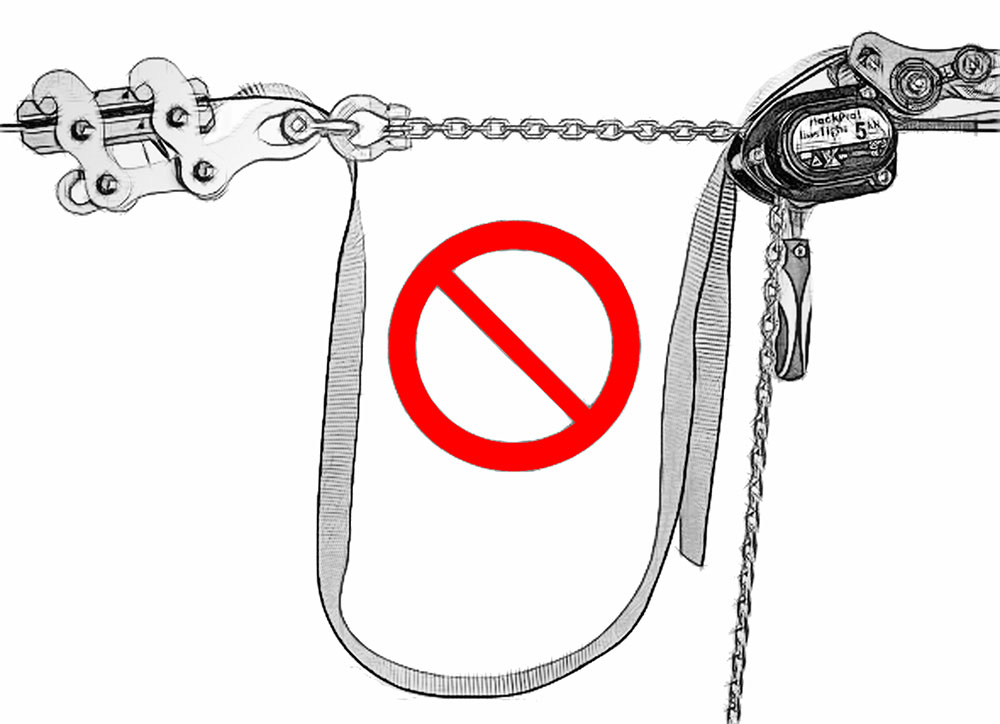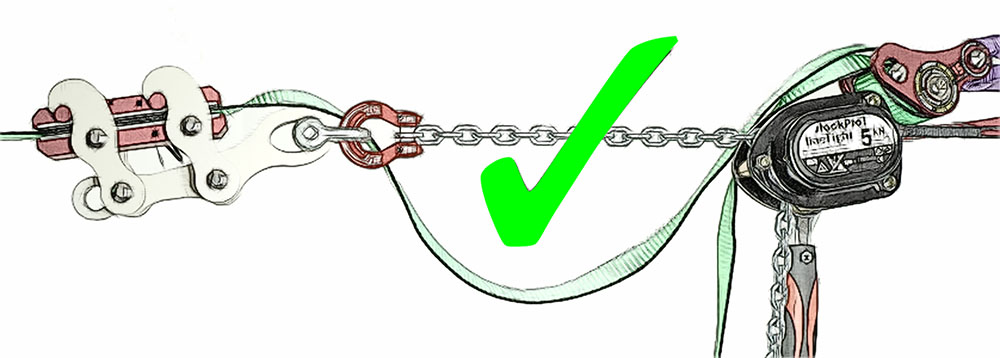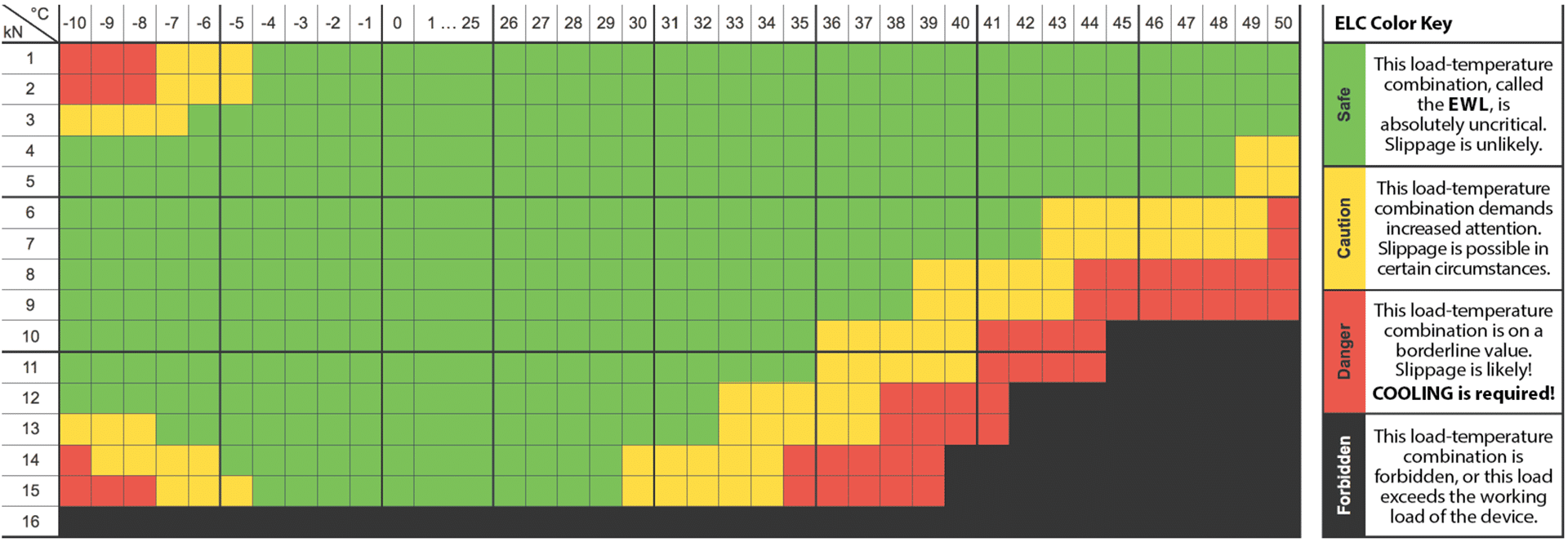lineGrip Safety and Warnings
The lineGrip is a super safe and reliable high tech tool – if operated correctly.
Just as with a high tech race car, you as the operator are responsible to adhere by certain do’s and dont’s.
For the lineGrip the most important ones are:
- Always backup the lineGrip with minimal slack during the tensioning phase!
- Never exceed the EWL (environmental working load), which is determined via the Temp-Load diagram!
- Keep an eye on the lineGrip’s (the rubber plate’s) temperature!
When following the safety instructions in your manual, the chances of your lineGrip failing, or even behaving unexpectantly, are near to zero.
Be aware, that the most common reason for unexpected lineGrip behaviour is high temperature!
Nevertheless, the lineGrip is not a magic tool, therefore issues sometimes do occur.
Click here to learn about any current reported issues >
Always backup the lineGrip with minimal slack during the tensioning phase!
Take safety precuations! Be aware, that high temperature will reduce the gripping power of the rubber! You as the operator are responsible to take any necessary safety precautions, to avoid accidents in case of slippage (e.g. reliable backup, keep bystanders clear)!

Wrong – Danger! This is too much slack!
Backup with as little slack as possible!
Strictly avoid having more than 30cm of slack webbing between the lineGrip and the anchor!
Reason: should the webbing slip in the lineGrip, it will not be stopped, until all slack has pulled through the lineGrip. The more webbing, the greater the momentum the webbing will develop, and the greater the risk of damage to your gear, and/or injuries to operators or bystanders.

Good – Safe!
If the slack approaches approx. 30cm, pause tensioning and take in the slack, or have a helper take in the slack continuously, while you keep tensioning. Be advised though, that while you are applying active tension to the tensioning device, hands must keep clear of any hardware in the system!
This will avoid any critical situations, damage, and injuries, should the webbing ever slip in the lineGrip due to any reason.
Never exceed the EWL (environmental working load)
The listed temperature in the following diagram is referring to the temperature of the rubber. In most situations this corresponds to the surface temperature of the clamping plates, which again corresponds to the ambient (air) temperature, when used only in the shade.
Please note: the rubber temperature may easily reach 70° C (160° F) if the device is subjected to direct sunlight! The lineGrip must always be protected from direct solar radiation, even when not in use!
The following diagram helps you to assess your lineGrip‘s environmental load condition (ELC), and determine your current environmental working load (EWL).
Temperature-Load Diagram for lineGrips with Type-3 Rubber Plates
A few examples with the lineGrip G5 for clarification:
When the ambient (air) temperature is around 30°C, the EWL is 13 kN, which means, it is absolutely uncritical to load the lineGrip G5 (and G4) with 13 kN pulling force. You may load it with up to 15 kN, but you should be cautios and alert, because at this temperature, slippage is possible when exceeding 13 kN.
When the ambient (air) temperature is around 40°C, the EWL is 7 kN, which means, it is absolutely uncritical to load the lineGrip G5 with 7 kN pulling force. You may load it with up to 11 kN, but you should be cautios and alert, because at this temperature, slippage is possible when exceeding 7 kN. At this temperature it is not advisable to exceed 11 kN without proper cooling of the lineGrip, because slippage is likely when doing so.
Learn more about cooling the lineGrip >
Please note!
All of these load values are to be understood as general guidelines. There are numerous factors that can negatively influence the gripping power of the lineGrip to your slackline. The above values assume proper condition of the rubber plates (less than 2 years old, undamaged) and the webbing used is in good condition and made of uncoated PES or PA (Nylon), free of pollution by dirt, debris, and substances other than pure water.
Please use common sense when assessing the EWL for your specific situation, and take all conceivable factors into account that could negatively influence the adherence of the rubber surface to your webbing.
Related articles:
Keep an eye on the lineGrip’s (the rubber plate’s) temperature!
The previous section explained the correlation between temperature and grip strength of the lineGrip. Therefore, it is very important to always keep an eye on the lineGrip’s temperature while you use it.
Keep in mind: The rubber temperature may easily reach 70° C (160° F), if the device is subjected to direct sunlight! The lineGrip must always be protected from direct solar radiation, even when not in use.
Whenever the lineGrip is in direct sunlight, it warms up above ambient temperature. This may happen quite fast. For example at 25° ambient, even the late afternoon summer sun will warm up the lineGrip plates from 25° to 40°C within less than half an hour, which results in a significant SWL drop from 15kN to only 7kN! It is hard to exactly determine the lineGrip’s temperature without a thermometer, but you may use the following guide to roughly estimate the lineGrip temperature.
Temperature estimation for a situation with about 25-30°C ambient temperature.
Firmly grab the lineGrip at the plates and hold tight for a few seconds. Then, if it…
- feels slightly warm – probable temperature: around 30°C
- feels noticably warm – probable temperature: 35°C
- feels very warm – probable temperature: 40°C
- feels hot – probable temperature: 45°C
- feels very hot – probable temperature: 50°C
- feels hard to hold on to for a few seconds – probable temperature: >55°C
Naturally, the sense of temperature is a very subjective matter which varies greatly from person to person, but you can probably assess how temperature sensitive you are. If you suppose you’re rather sensitive to temperature with the touch of your hand (e.g. subtle and soft skin), please subtract 5° from above values. If you suppose to be rather temperature unsensitive (e.g. rock climbers hands), please add 5° to above values.
Also, please take into account, that when your hands are cold, or the ambient temperature is low, you will be more sensitive to temperature, so please subtract 5° from above values.
The safest method, that will spare you the need to check the temperature of the lineGrip, is to keep it out of the sun! It’s temperature will then never exceed the ambient temperature, which you can determine fairly easily via weather app, etc.
If you can’t avoid using the lineGrip in direct sunlight, cool it! Do this by pouring cool water over the lineGrip (the clamping plates), or even better, wrap the the moistened lineGrip-Shell around the lineGrip. A moistened shell will guarantee to keep the lineGrip’s temperature below(!) ambient, even at 40°C in the sun.


